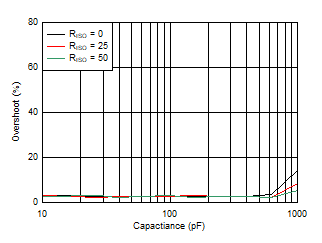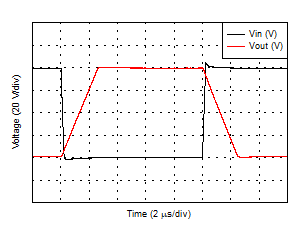SBOSA16 October 2020 OPA455
PRODUCTION DATA
- 1 Features
- 2 Applications
- 3 Description
- 4 Revision History
- 5 Pin Configuration and Functions
- 6 Specifications
- 7 Detailed Description
- 8 Application and Implementation
- 9 Power Supply Recommendations
- 10Layout
- 11Device and Documentation Support
- 12Mechanical, Packaging, and Orderable Information
Package Options
Mechanical Data (Package|Pins)
- DDA|8
Thermal pad, mechanical data (Package|Pins)
- DDA|8
Orderable Information
6.6 Typical Characteristics
at TA = 25°C, VS = ±75 V, and RL = 10 kΩ connected to GND, output enabled (unless otherwise noted)
Table 6-1 Table of Graphs
| DESCRIPTION | FIGURE |
|---|---|
| Offset Voltage Distribution at 25°C | Figure 6-1 |
| Offset Voltage Distribution at 85°C | Figure 6-2 |
| Offset Voltage Distribution at -40°C | Figure 6-3 |
| Offset Voltage Drift Distribution from -40°C to +85°C | Figure 6-4 |
| Offset Voltage vs Temperature | Figure 6-5 |
| Offset Voltage Warmup | Figure 6-6 |
| Offset Voltage vs Common-Mode Voltage (Low Vcm) | Figure 6-7 |
| Offset Voltage vs Common-Mode Voltage (High Vcm) | Figure 6-8 |
| Offset Voltage vs Power Supply (Low Supply) | Figure 6-9 |
| Offset Voltage vs Power Supply (High Supply) | Figure 6-10 |
| Offset Voltage vs Output Voltage (Low Output) | Figure 6-11 |
| Offset Voltage vs Output Voltage (High Output) | Figure 6-12 |
| CMRR vs Temperature | Figure 6-13 |
| CMRR vs Frequency | Figure 6-14 |
| PSRR vs Temperature | Figure 6-15 |
| PSRR vs Frequency | Figure 6-16 |
| EMIRR vs Frequency | Figure 6-17 |
| No Phase Reversal | Figure 6-18 |
| Input Bias Current Production Distribution at 25℃ | Figure 6-19 |
| IB vs Temperature | Figure 6-20 |
| IB vs Common-Mode Voltage | Figure 6-21 |
| Enable Response | Figure 6-22 |
| Current Limit Response | Figure 6-23 |
| Open-Loop Gain vs Temperature | Figure 6-24 |
| Open-Loop Gain vs Output Voltage | Figure 6-25 |
| Open-Loop Gain and Phase vs Frequency | Figure 6-26 |
| Open-Loop Output Impedance vs Frequency | Figure 6-27 |
| Closed-Loop Gain vs Frequency | Figure 6-28 |
| Maximum Output Voltage vs Frequency | Figure 6-29 |
| Positive Output Voltage vs Output Current | Figure 6-30 |
| Negative Output Voltage vs Output Current | Figure 6-31 |
| Short-Circuit Current vs Temperature | Figure 6-32 |
| Negative Overload Recovery | Figure 6-33 |
| Positive Overload Recovery | Figure 6-34 |
| Settling Time | Figure 6-35 |
| Phase Margin vs Capacitive Load | Figure 6-36 |
| Small-Signal Overshoot vs Capacitive Load (G = –1) | Figure 6-37 |
| Small-Signal Overshoot vs Capacitive Load (G = +1) | Figure 6-38 |
| Small-Signal Step Response (G = –1) | Figure 6-39 |
| Small-Signal Step Response (G = +1) | Figure 6-40 |
| Large-Signal Step Response (G = –1) | Figure 6-41 |
| Large-Signal Step Response (G = +1) | Figure 6-42 |
| Slew Rate vs Output Step Size | Figure 6-43 |
| Slew Rate vs Supply Voltage (Inverting) | Figure 6-44 |
| Slew Rate vs Supply Voltage (Noninverting) | Figure 6-45 |
| THD+N Ratio vs Frequency (G = 10) | Figure 6-46 |
| THD+N Ratio vs Frequency (G = 20) | Figure 6-47 |
| THD+N Ratio vs Output Amplitude (G = 10) | Figure 6-48 |
| THD+N Ratio vs Output Amplitude (G = 20) | Figure 6-49 |
| 0.1-Hz to 10-Hz Noise | Figure 6-50 |
| Input Voltage Noise Spectral Density | Figure 6-51 |
| Current Noise Density | Figure 6-52 |
| Quiescent Current Production Distribution at 25℃ | Figure 6-53 |
| Quiescent Current vs Supply Voltage | Figure 6-54 |
| Quiescent Current vs Temperature | Figure 6-55 |
| Status Flag Voltage vs Temperature | Figure 6-56 |
| Quiescent Current vs Enable Voltage | Figure 6-57 |
| Enable Current vs Enable Voltage | Figure 6-58 |
| Status Flag Current vs Voltage | Figure 6-59 |





(Low Supply)

(Low Output)










vs Output Current



| G = –1 |
vs Capacitive Load

| G = –1 |

| G = –1 |

 Figure 6-45 Slew Rate vs
Supply Voltage (Noninverting)
Figure 6-45 Slew Rate vs
Supply Voltage (Noninverting)
| G = 20 |

| G = 20 |







From –40°C to +85°C



(High Supply)

(High Output)









vs Output Current




| G = +1 |
vs Capacitive Load

| G = +1 |

| G = +1 |


| G = 10 |

| G = 10 |




